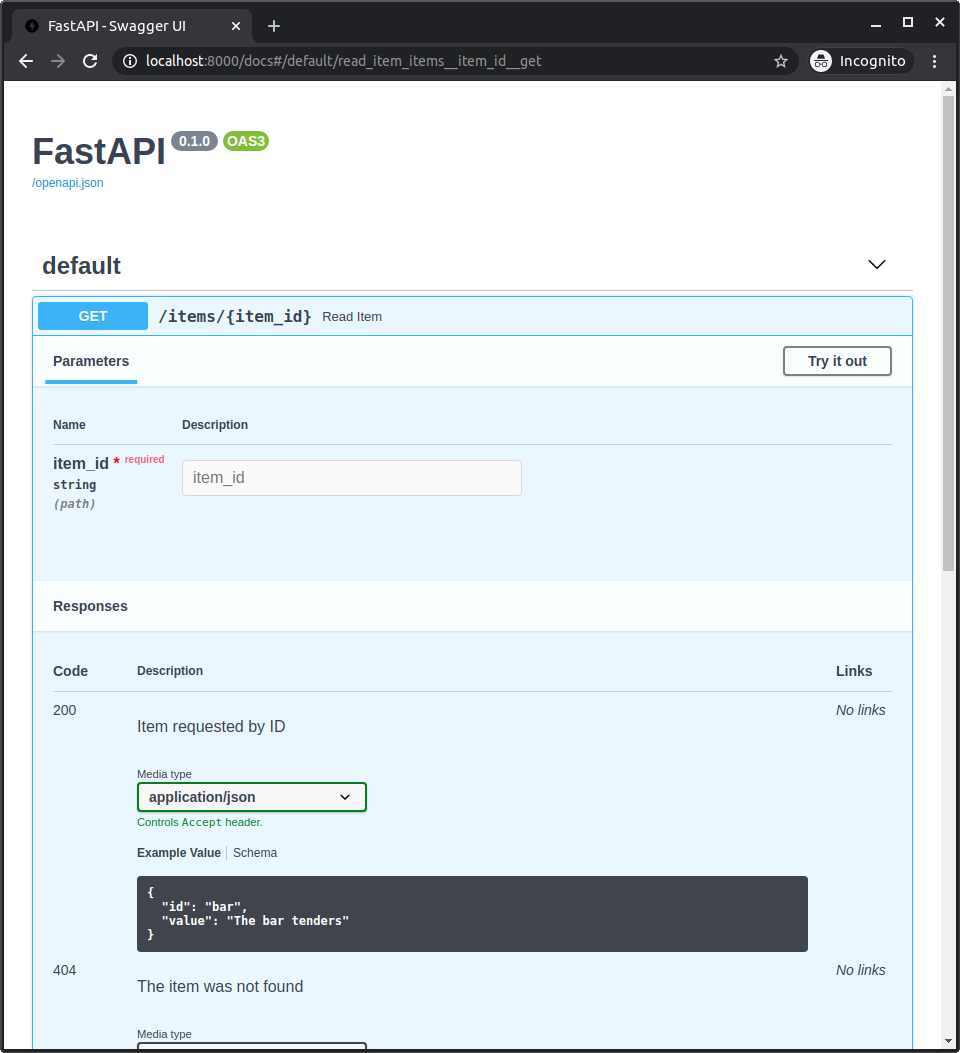OpenAPI 中的額外回應¶
警告
這是一個相當進階的主題。
如果您剛開始使用 FastAPI,您可能不需要用到這個。
您可以宣告額外的回應,包含額外的狀態碼、媒體類型、描述等等。
這些額外的回應將會包含在 OpenAPI schema 中,所以它們也會顯示在 API 文件中。
但對於這些額外的回應,您必須確保直接返回一個像 JSONResponse 之類的 Response,並附帶您的狀態碼和內容。
使用 model 的額外回應¶
您可以將一個名為 responses 的參數傳遞給您的*路徑操作裝飾器*。
它接收一個 dict:鍵是每個回應的狀態碼(例如 200),值是包含每個回應資訊的其他 dict。
每個回應 dict 都可以有一個鍵 model,其中包含一個 Pydantic 模型,就像 response_model 一樣。
FastAPI 會使用該模型,產生其 JSON Schema 並將其包含在 OpenAPI 中的正確位置。
例如,要宣告另一個狀態碼為 404 且具有 Pydantic 模型 Message 的回應,您可以這樣寫:
from fastapi import FastAPI
from fastapi.responses import JSONResponse
from pydantic import BaseModel
class Item(BaseModel):
id: str
value: str
class Message(BaseModel):
message: str
app = FastAPI()
@app.get("/items/{item_id}", response_model=Item, responses={404: {"model": Message}})
async def read_item(item_id: str):
if item_id == "foo":
return {"id": "foo", "value": "there goes my hero"}
return JSONResponse(status_code=404, content={"message": "Item not found"})
注意事項
請記住,您必須直接返回 JSONResponse。
資訊
model 鍵不是 OpenAPI 的一部分。
FastAPI 會從那裡取得 Pydantic 模型,產生 JSON Schema,並將其放在正確的位置。
正確的位置是
- 在鍵
content中,其值是另一個包含以下內容的 JSON 物件 (dict):- 一個鍵,其中包含媒體類型,例如
application/json,其值是另一個 JSON 物件,其中包含:- 一個鍵
schema,其值是來自模型的 JSON Schema,這裡就是正確的位置。- FastAPI 在這裡新增一個參考,指向 OpenAPI 中其他位置的全局 JSON Schemas,而不是直接包含它。這樣,其他應用程式和客戶端可以直接使用這些 JSON Schemas,提供更好的程式碼產生工具等等。
- 一個鍵
- 一個鍵,其中包含媒體類型,例如
為此*路徑操作*產生的 OpenAPI 回應將會是
{
"responses": {
"404": {
"description": "Additional Response",
"content": {
"application/json": {
"schema": {
"$ref": "#/components/schemas/Message"
}
}
}
},
"200": {
"description": "Successful Response",
"content": {
"application/json": {
"schema": {
"$ref": "#/components/schemas/Item"
}
}
}
},
"422": {
"description": "Validation Error",
"content": {
"application/json": {
"schema": {
"$ref": "#/components/schemas/HTTPValidationError"
}
}
}
}
}
}
這些 schemas 被參考到 OpenAPI schema 內的另一個位置。
{
"components": {
"schemas": {
"Message": {
"title": "Message",
"required": [
"message"
],
"type": "object",
"properties": {
"message": {
"title": "Message",
"type": "string"
}
}
},
"Item": {
"title": "Item",
"required": [
"id",
"value"
],
"type": "object",
"properties": {
"id": {
"title": "Id",
"type": "string"
},
"value": {
"title": "Value",
"type": "string"
}
}
},
"ValidationError": {
"title": "ValidationError",
"required": [
"loc",
"msg",
"type"
],
"type": "object",
"properties": {
"loc": {
"title": "Location",
"type": "array",
"items": {
"type": "string"
}
},
"msg": {
"title": "Message",
"type": "string"
},
"type": {
"title": "Error Type",
"type": "string"
}
}
},
"HTTPValidationError": {
"title": "HTTPValidationError",
"type": "object",
"properties": {
"detail": {
"title": "Detail",
"type": "array",
"items": {
"$ref": "#/components/schemas/ValidationError"
}
}
}
}
}
}
}
主要回應的額外媒體類型¶
您可以使用相同的 responses 參數為同一個主要回應新增不同的媒體類型。
例如,您可以新增 image/png 的額外媒體類型,宣告您的*路徑操作*可以返回 JSON 物件(媒體類型為 application/json)或 PNG 圖片。
from typing import Union
from fastapi import FastAPI
from fastapi.responses import FileResponse
from pydantic import BaseModel
class Item(BaseModel):
id: str
value: str
app = FastAPI()
@app.get(
"/items/{item_id}",
response_model=Item,
responses={
200: {
"content": {"image/png": {}},
"description": "Return the JSON item or an image.",
}
},
)
async def read_item(item_id: str, img: Union[bool, None] = None):
if img:
return FileResponse("image.png", media_type="image/png")
else:
return {"id": "foo", "value": "there goes my hero"}
注意事項
請注意,您必須使用 FileResponse 直接返回圖片。
資訊
除非您在 responses 參數中明確指定不同的媒體類型,否則 FastAPI 會假設回應的媒體類型與主要回應類別相同(預設為 application/json)。
但是,如果您已使用 None 作為其媒體類型指定了自定義回應類別,則 FastAPI 將會對任何具有關聯模型的額外回應使用 application/json。
合併資訊¶
您也可以合併來自多個位置的回應資訊,包括 response_model、status_code 和 responses 參數。
您可以使用預設狀態碼 200(或您需要的自定義狀態碼)宣告 response_model,然後在 OpenAPI schema 中的 responses 中直接為該回應宣告額外資訊。
FastAPI 會保留來自 responses 的額外資訊,並將其與模型中的 JSON Schema 結合。
例如,您可以宣告一個狀態碼為 404 的回應,它使用一個 Pydantic 模型,並帶有一個自訂的 description(描述)。
以及一個狀態碼為 200 的回應,它使用您的 response_model(回應模型),但包含一個自訂的 example(範例)。
from fastapi import FastAPI
from fastapi.responses import JSONResponse
from pydantic import BaseModel
class Item(BaseModel):
id: str
value: str
class Message(BaseModel):
message: str
app = FastAPI()
@app.get(
"/items/{item_id}",
response_model=Item,
responses={
404: {"model": Message, "description": "The item was not found"},
200: {
"description": "Item requested by ID",
"content": {
"application/json": {
"example": {"id": "bar", "value": "The bar tenders"}
}
},
},
},
)
async def read_item(item_id: str):
if item_id == "foo":
return {"id": "foo", "value": "there goes my hero"}
else:
return JSONResponse(status_code=404, content={"message": "Item not found"})
所有這些都將被合併並包含在您的 OpenAPI 中,並顯示在 API 文件中。

結合預定義回應和自訂回應¶
您可能希望有一些預定義的回應適用於許多*路徑操作*,但您希望將它們與每個*路徑操作*所需的客製化回應結合起來。
在這些情況下,您可以使用 Python 的「解包」技巧,透過 **dict_to_unpack 來解包一個 dict(字典)。
old_dict = {
"old key": "old value",
"second old key": "second old value",
}
new_dict = {**old_dict, "new key": "new value"}
在這裡,new_dict(新字典)將包含 old_dict(舊字典)中的所有鍵值對,以及新的鍵值對。
{
"old key": "old value",
"second old key": "second old value",
"new key": "new value",
}
您可以使用該技巧在您的*路徑操作*中重複使用一些預定義的回應,並將它們與其他自訂回應結合起來。
例如:
from typing import Union
from fastapi import FastAPI
from fastapi.responses import FileResponse
from pydantic import BaseModel
class Item(BaseModel):
id: str
value: str
responses = {
404: {"description": "Item not found"},
302: {"description": "The item was moved"},
403: {"description": "Not enough privileges"},
}
app = FastAPI()
@app.get(
"/items/{item_id}",
response_model=Item,
responses={**responses, 200: {"content": {"image/png": {}}}},
)
async def read_item(item_id: str, img: Union[bool, None] = None):
if img:
return FileResponse("image.png", media_type="image/png")
else:
return {"id": "foo", "value": "there goes my hero"}
關於 OpenAPI 回應的更多資訊¶
要查看您可以在回應中包含哪些內容,您可以查看 OpenAPI 規範中的這些章節:
- OpenAPI 回應物件,它包含了
回應物件。 - OpenAPI 回應物件,您可以直接將其中的任何內容包含在
responses參數內的每個回應中。包括description(描述)、headers(標頭)、content(內容)(在其中宣告不同的媒體類型和 JSON Schema)以及links(連結)。